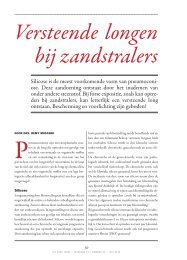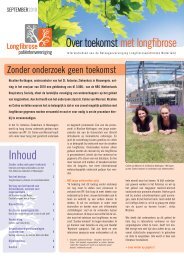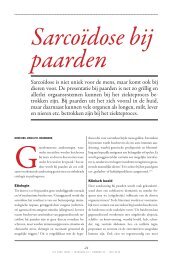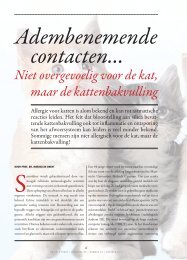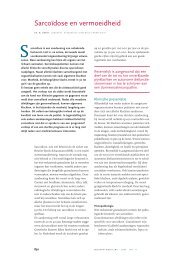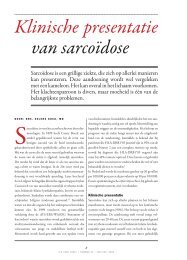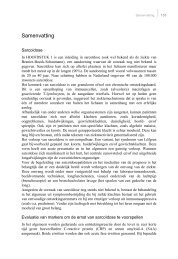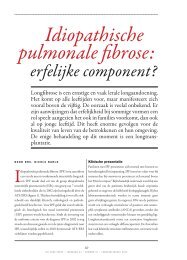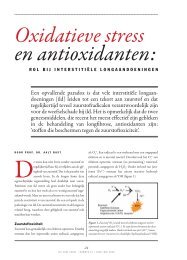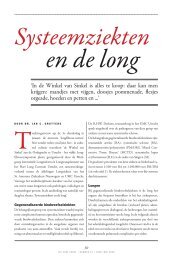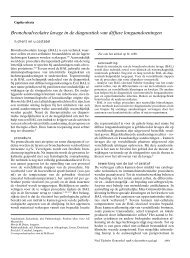Interpretation of bronchoalveolar lavage fluid cytology - ILD care
Interpretation of bronchoalveolar lavage fluid cytology - ILD care
Interpretation of bronchoalveolar lavage fluid cytology - ILD care
You also want an ePaper? Increase the reach of your titles
YUMPU automatically turns print PDFs into web optimized ePapers that Google loves.
<strong>Interpretation</strong> <strong>of</strong> BALF <strong>cytology</strong><br />
Learning set<br />
The three respective prior probabilities that an arbitrary patient with IDL (without using any additional information)<br />
actually belonged to a diagnostic group were, for sarcoidosis 100(190/272)=69.9%, for EAA 100(38/272)=14.0%,<br />
and for IPF 100(44/272)=16.2%. The percentage <strong>of</strong> patients correctly classified among all patients with a given<br />
actual diagnosis, called the "diagnostic effectiveness" [19] or sensitivity, was 100 ([180+31+37]/272)=91.2. The<br />
diagnostic effectiveness for sarcoidosis was 100(180/190)= 94.7%,for EAA 100(31/38)=81.6%, and IPF 100(-<br />
37/44)= 84.1% (Table 4). The predicted value <strong>of</strong> a classification can be calculated as the probability that a patient<br />
actually belongs in the predicted group. For the classification <strong>of</strong> sarcoidosis, the predicted value (PV + ) was<br />
100(180/192)=93.8%, and for the classification <strong>of</strong> EAA and IPF, the corresponding values were 100(31/36)= 86.1%<br />
and 100(37/44)=84.1%, respectively.<br />
The specificity, or probability <strong>of</strong> nonsarcoidosis in the group without sarcoidosis was 100([31+1+1<br />
+37]/[38+44])=85.4%, for non-EAA it was 100x([180+6+6+37]/[190+44])=97.9%, and for non-IPF is was<br />
100([180+4+6+31]/[190+38])=96.9%.<br />
The predicted value <strong>of</strong> the negative result (PV - ) for the group with nonsarcoidosis was 100([31+1+1+37]/ [36+ 44])=<br />
87.5%, for non-EAA it was 100([180+6+6+37]/[192+44])=97.0%, and for non-IPF it was 100([180+<br />
4+6+31]/[192+36])=96.9% (see Table 4).<br />
Test set<br />
In order to validate the computer program in a patient population independent <strong>of</strong> the learning population, a<br />
population having the selected <strong>ILD</strong> from another hospital was used as a test set. The diagnoses <strong>of</strong> sarcoidosis,<br />
EAA, and IPF had been established by the diagnostic procedures described earlier, independently <strong>of</strong> the BALFanalysis<br />
results.<br />
The three respective prior probabilities that an arbitrary patient (without using any additional information) actually<br />
belonged to a diagnostic group were, for sarcoidosis 100(91/128)=71.1%, for EAA 100(5/128)=3.9%, and for IPF<br />
100(32/128)=25.0%.<br />
The percentage <strong>of</strong> patients correctly classified among all patients in the test set with a given actual diagnosis, or<br />
diagnostic effectiveness, was 100([85+4+32]/ 128)=94.5. The diagnostic effectiveness for sarcoidosis was<br />
100(85/91)= 93.4%, for EAA 100(4/5)=80.0%, and for IPF 100 (32/32)=100% (Table 4). For the diagnosis <strong>of</strong><br />
sarcoidosis, the predicted value (PV + ) was 100(85/86)= 98.8%, and for the diagnoses <strong>of</strong> EAA and IPF, these values<br />
were 100(4/5)= 80.0% and 100(32/37)=86.5%, respectively.<br />
The specificity, or the probability <strong>of</strong> the prediction <strong>of</strong> nonsarcoidosis in the group without sarcoidosis, was<br />
100([4+0+0+32]/[5+32])=97.3%, for non-EAA it was 100([85+5+0+32]/[91+ 32])=99.2%, and for non-IPF 100([85<br />
+1+1+4]/[91+5])=94.8%. The predicted value <strong>of</strong> the negative result (PV - ) for the group with nonsarcoidosis was<br />
100([4+ 0+0+32]/[5+37])=85.7%, for non-EAA it was 100([85+5+0+32]/[86+37])= 99.2%, and for non-IPF it was<br />
100([85+1+ 1+4] /[86+5])=100% (Table 4).<br />
Discussion<br />
The present study illustrates that the polychotomous logistic regression model (computer program) developed in the<br />
study can be used to predict the most likely <strong>of</strong> the three common diagnoses within <strong>ILD</strong> (i.e., sarcoidosis, EAA, and<br />
IPF), given a patient's cellular BALF-analysis results. The model provided a correct prediction in 91.2% <strong>of</strong> the<br />
learning population, and <strong>of</strong> 94.5% in the respective independent test set used to validate the computer program,<br />
irrespective <strong>of</strong> any other clinical information. In most cases the program predicted the correct diagnosis with great<br />
sensitivity as well as specificity. Moreover, when the outcome <strong>of</strong> the program differed from the physician's judgment,<br />
it calculated a substantial percentage although not the highest, <strong>of</strong> the correct diagnosis. As far as we know, this is<br />
the first validated computer program to be a practical diagnostic guide when interpreting BALF-analysis results <strong>of</strong><br />
patients with <strong>ILD</strong>. However, the analysis developed in the present study includes only BALF features having to do<br />
with the presentation <strong>of</strong> the disease; the computer program based on the analysis cannot provide the prognosis for<br />
such patients or predict their response <strong>of</strong> therapy. Furthermore, the program differentiates only the three types <strong>of</strong><br />
<strong>ILD</strong>, that were studied, and not among other pulmonary disorders. Disorders with a similar clinical presentation<br />
requiring rapid diagnosis and a totally different management approach, such as malignancies and infections, should<br />
particularly be distinguished from one another. However, such disorders have specific diagnostic features, such as<br />
tumour cells or pathogenic microorganisms, and their diagnosis is not based on inflammatory cell differentiation per<br />
S<strong>of</strong>tware to evaluate BALF analysis. Drent et al. Am J Respir Crit Care Med 1996.<br />
7



